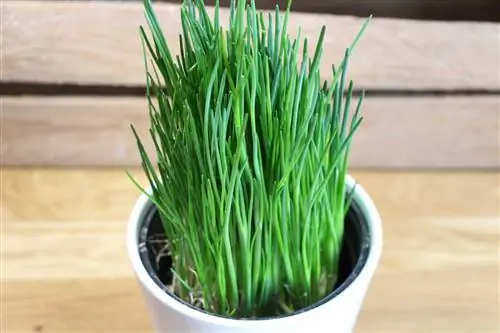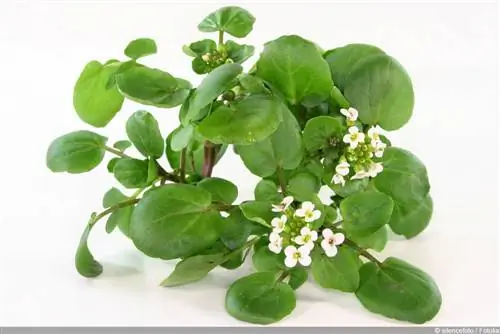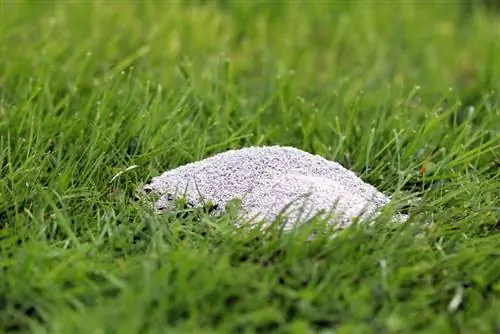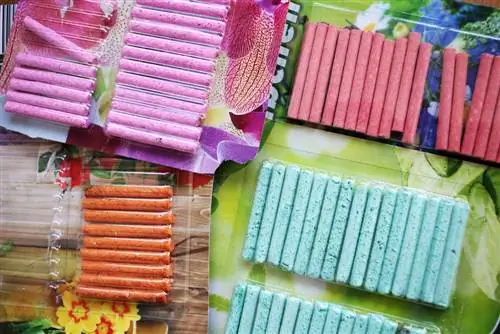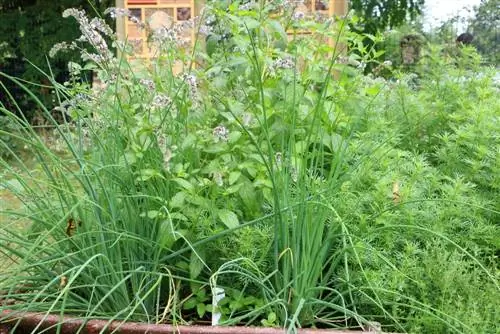- Author admin [email protected].
- Public 2023-12-17 03:39.
- Last modified 2025-01-24 12:45.
Chives belong to the allium family and are notable for their light to strong onion flavor. Chives are one of the most popular garden herbs and for that reason alone they belong in every herb garden.
Sowing
Chives are easy to care for when they are sown. The small black seeds can simply be sprinkled onto the loose soil and covered lightly. Watering is of course good, but that's all you need. Chives can grow in pots on the windowsill as well as in balcony boxes or outdoors. Outdoors, the plant has a benefit that you don't usually read about: the plant's strong aromatic scents keep pests away. So it can definitely make sense to sow chives in a mixed culture with other herbs, flowers or vegetables. If you want to use the flowers in the kitchen in addition to the stems, you should pay attention to the variety: Not all varieties have edible flowers.
Chives like moist, loose soil and a sunny location, but also thrive in partial shade. Dark, shady corners in the kitchen garden, on the other hand, are unsuitable. As with almost all herbs, calcareous soils with lots of nutrients are an advantage. It is optimal if chives are sown early in April, but they also thrive if sown later. Chives germinate after about seven to fourteen days and can grow up to 50 cm high.
Harvest
Chives are a grateful plant; they produce green leaves that are ready to be harvested almost all year round. To ensure greater leaf growth, the flowers should be cut off - unless you also want to use them in the kitchen. To harvest, the leaves and flowers are simply cut off relatively close to the ground, ideally about two centimeters above the ground.
Care
Chives need to be watered regularly, and it is important to fertilize regularly, especially in flower pots and balcony boxes. A herbal fertilizer from a specialist retailer is perfect, but outdoors you can also fertilize with compost or other products. Water the plants regularly, chives not only need a lot of water, but also like to be moist.
Chives are winter-hardy, so they can be left outside even in the cold season. However, the leaves should be cut off completely shortly before the onset of winter. Chives are a bulbous plant. Although the onions are hardy, they should be covered if necessary. A tarpaulin or a few coniferous branches are sufficient. The plant germinates very quickly in spring and leaves can be harvested again in April.
Share
Chives are rampant - the plants expand rapidly if they are well cared for, and the pot soon becomes too crowded. That's why chives should be divided about every three years, in pots as well as in balcony boxes and outdoors. To do this, the plant is divided with a spade or a digging fork and the root ball is simply cut through with a sharp knife. The new parts of the plant can be replanted outdoors with plenty of space and develop into new plants of their own. If the chives are kept indoors, add a second pot or another box or bucket. If chives are not divided, the leaves grow more and more delicately and very hesitantly. The best time to divide plants is in spring.
Chives as a pest controller
Chives have strong essential oils, which not only provide the pungent taste, but are also responsible for a rather pungent smell. What is sometimes a bit unpleasant for us humans is something that pests don't necessarily like either. Chives keep many pests away by their mere presence in the garden. For example in the rose bed: rust fungi attack roses much less often if chives grow next to them. In the carrot field, chives keep the carrot fly away. And what applies outdoors is of course also the case on the balcony: chives and roses in a large pot make perfect sense.
Using chives
In spring, chives are one of the first garden herbs to sprout and can be harvested as early as April. The plants can be divided and propagated as early as the second year. However, the plants should only be divided every max. 3 years.
Chives are widely used in the kitchen by everyone who values he althy food and beautiful decoration. Homemade herb butter with chives, parsley and many other herbs tastes great and is also very he althy. To improve the taste, it is used for numerous dishes: poultry and meat dishes, soups, stews and eggs, as well as for hearty salads and simple sandwiches.
Store dry chives
If there are too many chives available in summer, you can easily freeze them. It does not lose its color, can be defrosted at any time and does not collapse, but appears to be freshly harvested. Rinse the chives well and cut them into very small sections (see photo). If you need some chives for a stew, for example, you can always open the plastic bag and scrape out some chives with a knife - the aroma and the color are retained.
Chives taste good. It is popular in the kitchen on mashed potatoes, in salad dressings, with vegetables and meat. It can be found in almost every herb garden and on almost every windowsill. Chives provide flavor and vitamins, and they taste best fresh. You don't have to buy it - you can easily grow chives yourself, from sowing to caring for the perennial plants to regular cutting, you can find all the information in the following description.
The special tip: chive flowers
Chives are part of the allium family and are very rich in vitamins. It contains vitamins E, C, A, K and B6, as well as thiamine, folic acid, riboflavin and niacin. Chives also contain large amounts of potassium, calcium, iron, magnesium and phosphorus. So, at least from a nutritional point of view, there is something to be said for treating yourself to a hearty piece of bread with cream cheese and lots of fresh chives every now and then - not to mention the incomparable taste experience. It is always said that the eye eats too. If you not only add the green leaves of the leek, finely chopped, to the bread, but also cut off the flowers close to the stem so that they break down into individual, small flowers, they not only taste delicious mixed in on the bread, but they also look whole enchanting. The flowers contain roughly the same nutrients as the leaves, but also have a slightly sweet, honey-like taste. And what works with the bread also works in the Frankfurt Green Sauce, which then becomes a purple sauce. Be careful not to end up eating the hard flower stalk - it tastes a bit bitter and is difficult to chew.
Tips for speed readers
- Sow outdoors at the beginning of April, ideal as a mixed culture. Chives also grow on the windowsill.
- Pay attention to partially shaded to sunny locations in moist, nutrient-rich soil.
- Germination time: 7 to 14 days
- Height of plants: up to 50 cm.
- Leaves can be harvested all year round, flowers should be cut off to ensure abundant leaf growth (but many varieties are also edible).
- Water regularly, keep the soil moist, pay attention to lots of nutrients (fertilize).
- Before the onset of winter, remove all greenery and, if necessary, cover the onions with coniferous branches or a tarpaulin.
- Chives germinate quickly in spring and can be harvested from April.
- Divide every three years in spring: divide with a spade and a sharp knife and replant separately at a distance.
- Chives can keep rust fungi away from roses and the carrot fly away from carrots when they grow next to the plants.
- Special tip: eat the chopped chive flowers.
Interesting facts
Chives are very rich in vitamins and minerals. The proportion of vitamin C in particular is very high (49mg/100g), but the potassium and phosphorus content also make chives a very valuable spice.
Savory herbs include herbs from Provence, sage, chervil and fennel.

